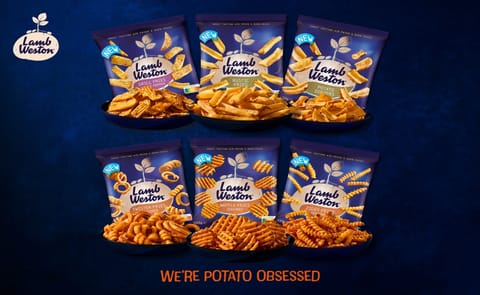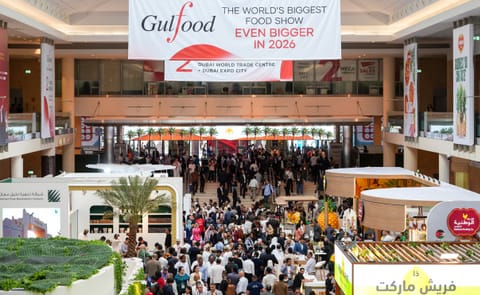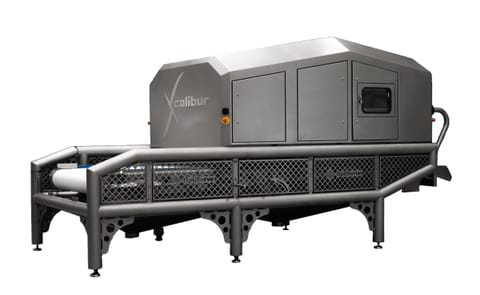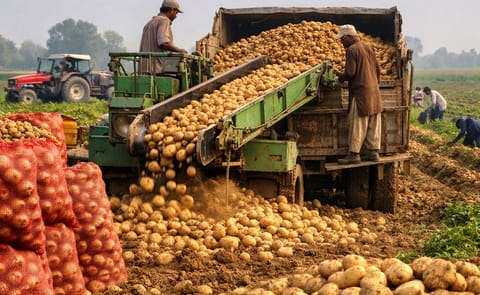Lamb Weston Reports Fiscal First Quarter 2023 Results; Reaffirms Fiscal Year 2023 Outlook.
Primaire tabs
Lamb Weston Reports Fiscal First Quarter 2023 Results; Reaffirms Fiscal Year 2023 Outlook

Tom Werner, President and CEO at Lamb Weston Holdings, Inc.:
"We drove strong sales, earnings growth, and gross margin expansion in the quarter by executing pricing actions across each of our business segments and generating manufacturing cost-savings to counter inflation."
"While volume declined as a result of softer restaurant traffic trends and supply chain constraints impacting production run-rates in our plants, we continued to make progress in improving customer service levels."
"We continue to manage through this difficult macro environment and are on track to deliver the higher end of our fiscal 2023 financial targets, including gross margins approaching normalized levels during the second half of the year."
"We expect the potato crop in our growing regions to be at the lower end of historical averages with good overall quality and below average yields due to the significant heat waves late in the season."
"While near-term demand trends may continue to be volatile as consumers navigate this inflationary environment, our recent announcement to expand capacity in Argentina, along with our ongoing investments in Idaho and China, demonstrate our confidence in the long-term health and growth outlook of the frozen potato category."
Q1 2023 Commentary
Net sales increased USD 141.4 million to USD 1,125.6 million, up 14 percent versus the prior year quarter. Price/mix increased 19 percent, reflecting the benefit of pricing actions across each of the Company’s core business segments to offset input, manufacturing, and transportation cost inflation.
Volume declined 5 percent, primarily reflecting softer casual dining and full-service restaurant traffic in the U.S. as well as the timing of shipments to large chain restaurant customers.
Shipments into foodservice and retail channels in the U.S. continued to be affected by an inability to fully serve customer demand due to widespread industry supply chain constraints, including labor and commodities shortages, that impacted production run-rates and throughput in the Company’s production facilities.
Income from operations increased USD 96.8 million to USD 157.0 million, up 161 percent versus the prior year quarter, reflecting higher gross profit, partially offset by higher selling, general and administrative expenses ("SG&A").
Gross profit increased USD 122.0 million, as the benefits from higher price/mix and productivity initiatives more than offset the impact of higher manufacturing and distribution costs on a per pound basis, as well as lower sales volumes.
The higher costs per pound primarily reflected double-digit cost inflation for key inputs, including: edible oils, ingredients such as grains and starches used in product coatings, labor costs, and transportation costs.
The increase in costs per pound also reflected higher costs associated with the impact of extreme summer heat that negatively affected the yield and quality of potato crops in the Pacific Northwest in fall of 2021, as well as the effects of labor and commodities shortages on production run-rates.
The increase in gross profit also included a USD 2.8 million increase in unrealized mark-to-market adjustments associated with commodity hedging contracts, which includes a USD 4.0 million loss in the current quarter, compared with a USD 6.8 million loss related to these items in the prior year quarter.
SG&A increased USD 25.2 million compared to the prior year quarter, primarily due to higher compensation and benefits expense, and higher expenses related to improving the Company’s information and technology services infrastructure. Net income was USD 231.9 million, up USD 202.1 million versus the prior year quarter, and Diluted EPS was USD 1.60, up USD 1.40 versus the prior year quarter.
The increases were driven by a USD 141.3 million increase (USD 104.9 million after-tax, or USD 0.73 per share) in unrealized mark-to-market adjustments associated with natural gas and electricity hedging contracts in the Company’s joint venture in Europe, higher income from operations, and a USD 15.1 million gain (before and after-tax, or USD 0.10 per share) recognized in connection with the Company’s acquisition in July 2022 of an additional 40 percent interest in Lamb Weston Alimentos Modernos S.A. ("LWAMSA"), its joint venture in Argentina.
The gain related to the remeasuring of the Company’s previously held 50 percent ownership interest to fair value. The Company has identified the mark-to-market adjustments related to natural gas and electricity derivatives in the current and prior year quarters, as well as the LWAMSA gain in the current quarter as items impacting comparability.
Adjusted Net Income(1) was USD 108.2 million, up USD 82.1 million versus the prior year quarter, and Adjusted Diluted EPS(1) was USD 0.75, up USD 0.57 versus the prior year quarter. Adjusted EBITDA including unconsolidated joint ventures(1) increased USD 109.4 million to USD 227.8 million, up 92 percent versus the prior year quarter. These increases were driven primarily by higher income from operations.
The Company’s effective tax rate(2) in the first fiscal quarter was 24.1 percent, versus 22.6 percent in the prior year quarter. The Company’s effective tax rate varies from the U.S. statutory tax rate of 21 percent principally due to the impact of U.S. state taxes, foreign taxes, permanent differences, and discrete items. Excluding items impacting comparability, the Company’s effective tax rate was 25.0 percent.
Q1 2023 Segment Highlights
Global
The benefit of domestic and international product and freight pricing actions to offset inflation, as well as favorable mix, drove a 14 percent increase in price/mix.
The timing of shipments to large QSR chain customers in the U.S., including the effect of lapping a notable limited time product offering in the prior year quarter, largely drove the 2 percent decline in volume. Export shipments declined modestly primarily due to production volumes being diverted to higher-margin sales channels in the U.S.
Global segment product contribution margin increased USD 41.1 million to USD 83.7 million, up 96 percent versus the prior year quarter. Favorable price/mix, primarily reflecting the benefit of pricing actions, drove the increase, more than offsetting higher manufacturing and distribution costs per pound.
Foodservice
Net sales for the Foodservice segment, which services North American foodservice distributors and restaurant chains generally outside the top 100 North American based restaurant chain customers, increased USD 44.9 million to USD 366.3 million, up 14 percent versus the prior year quarter, with price/mix up 26 percent and volume down 12 percent.
The carryover benefits of product and freight pricing actions taken in the prior year as well as early in fiscal 2023 to offset inflation drove the increase in price/mix.
Demand in the segment’s restaurant and non-commercial channels (such as lodging and hospitality, healthcare, schools and universities, sports and entertainment, and workplace environments) softened along with restaurant traffic as inflation pressured consumer discretionary spending.
The slowdown in restaurant traffic and consumer demand was more pronounced in casual dining and other full-service restaurants than in QSRs.
Shipments were also affected by an inability to fully serve customer demand due to widespread industry supply chain constraints, including labor and commodities shortages that impacted production run-rates and throughput in the Company’s production facilities, as well as incremental losses of certain low-margin non-commercial business.
Foodservice segment product contribution margin increased USD 41.8 million to USD 138.2 million, up 43 percent compared to the prior year quarter. Favorable price drove the increase, and was partially offset by higher manufacturing and distribution costs per pound, and the impact of lower sales volumes.
Retail
Net sales for the Retail segment, which includes sales of branded and private label products to grocery, mass merchant, and club customers in North America, increased USD 37.1 million to USD 169.6 million, up 28 percent versus the prior year quarter, with price/mix up 32 percent and volume down 4 percent.
The carryover benefits of pricing actions across the branded and private label portfolios taken in the prior year as well as earlier in fiscal 2023 to counter inflation drove the increase in price/mix. Lower shipments of private label products, resulting from incremental losses of certain low-margin business, drove the sales volume decline.
Shipments of branded products increased, although growth was tempered by an inability to fully serve customer demand due to constrained production run-rates and throughput in the Company’s production facilities.
Retail segment product contribution margin increased USD 33.9 million to USD 48.7 million, up 229 percent versus the prior year quarter. The benefits of pricing actions and favorable mix drove the increase, partially offset by higher manufacturing and distribution costs per pound.
Equity Method Investment Earnings
Equity method investment earnings from unconsolidated joint ventures in Europe, the U.S., and South America were USD 174.6 million and USD 6.2 million for first quarter of fiscal 2023 and 2022, respectively.
Equity method investment earnings in the quarter include a USD 144.6 million unrealized gain related to mark-to-market adjustments associated with currency and commodity hedging contracts, of which USD 146.3 million (USD 108.6 million after-tax, or USD 0.75 per share) related to changes in natural gas and electricity derivatives as commodity markets in Europe have experienced significant volatility.
Equity method investment earnings in the prior year quarter include a USD 4.3 million unrealized gain for mark-to-market adjustments, of which USD 5.0 million related to changes in natural gas and electricity derivatives.
Equity method investment earnings also include a USD 15.1 million gain (before and after-tax, or USD 0.10 per share) recognized in connection with the Company’s acquisition of an additional 40 percent interest in LWAMSA. The gain related to remeasuring the Company’s previously held 50 percent ownership interest to fair value.
Excluding the items impacting comparability noted above and the other mark-to-market adjustments, earnings from equity method investments increased USD 13.0 million compared to the prior year quarter, reflecting favorable price/mix, partially offset by higher manufacturing and distribution costs in both Europe and the U.S.
Liquidity and Cash Flows
Net cash provided by operating activities was USD 192.1 million, up USD 30.3 million versus the prior year quarter, primarily due to higher earnings. Capital expenditures, including information technology expenditures, were USD 121.2 million, up USD 42.3 million versus the prior year quarter, primarily reflecting increased investments to support capacity expansion projects.
In July 2022, the Company paid USD 42.3 million to increase its ownership in LWAMSA. The Company’s total ownership in the joint venture is now 90 percent. The Company began consolidating LWAMSA’s results in its consolidated financial statements following the acquisition.
Capital Returned to Shareholders
In the first quarter, the Company returned a total of USD 63.7 million to shareholders, including USD 35.3 million in cash dividends and USD 28.4 million through share repurchases. The Company repurchased 404,476 shares during the first quarter of fiscal 2023 at an average price per share of USD 70.11. The Company has approximately USD 241 million remaining under its existing share repurchase program.
Fiscal 2023 Outlook
The Company is reaffirming its financial targets for fiscal 2023, which include:
- Net sales of USD 4.7 billion to USD 4.8 billion, with growth versus the prior year primarily driven by the benefit of pricing actions to offset significant input and transportation cost inflation, as well as favorable mix.
- Including items impacting comparability of USD 161.4 million (approximately USD 123.7 million after-tax, or USD 0.85 per share), net income of USD 485 million to USD 535 million and Diluted EPS of USD 3.30 to USD 3.70.
- Excluding items impacting comparability, Adjusted Net Income(1) of USD 360 million to USD 410 million, Adjusted Diluted EPS(1) of USD 2.45 to USD 2.85, and Adjusted EBITDA including unconsolidated joint ventures(1) of USD 840 million to USD 910 million, with growth versus the prior year driven by higher sales and gross margin expansion.
The Company continues to expect SG&A of USD 475 million to USD 500 million, reflecting increased higher compensation and benefits costs, increased investments to upgrade its information systems and enterprise resource planning (“ERP”) infrastructure, and higher advertising and promotion expenses. - During the first half of fiscal 2023, the Company continues to expect its gross margins will be pressured as compared to normalized seasonal rates as it continues to manage through significant inflation for key production inputs, transportation and packaging, as well as higher raw potato costs on a per pound basis due to the impact of extreme summer heat that negatively affected the yield and quality of potato crops in the Pacific Northwest in fall 2021.
The Company continues to expect its gross margins will also be pressured by ongoing industrywide operational challenges, including labor and commodities shortages, resulting from volatility in the broader supply chain. - During the second half of fiscal 2023, the Company continues to expect gross margins will improve and approach a normalized annual rate of 25 percent to 26 percent.
The anticipated improvement is predicated on a U.S. potato crop harvested in fall 2022 that is in line with historical averages, particularly in its primary growing regions in the Columbia Basin and Idaho; the continued successful implementation of the Company’s pricing actions to offset input and transportation costs inflation; and a broad easing of labor and logistics pressures that have been constraining the Company’s production and shipments.
- Interest expense, net of approximately USD 115 million;
- Depreciation and amortization expense of approximately USD 210 million;
- Cash used for capital expenditures of USD 475 million to USD 525 million; and an
- Effective tax rate(2) (full year) of approximately 24 percent.
End Notes
(1) Adjusted Net Income, Adjusted Diluted EPS, and Adjusted EBITDA including unconsolidated joint ventures are non-GAAP financial measures. Please see the discussion of non-GAAP financial measures, including a discussion of earnings guidance provided on a non-GAAP basis, and the associated reconciliations at the end of this press release for more information.
(2)The effective tax rate vis calculated as the ratio of income tax expense to pre-tax income, inclusive of equity method investment earnings.
(3)For more information about product contribution margin, please see “Non-GAAP Financial Measures” and the table titled “Segment Information” included in this press release.













